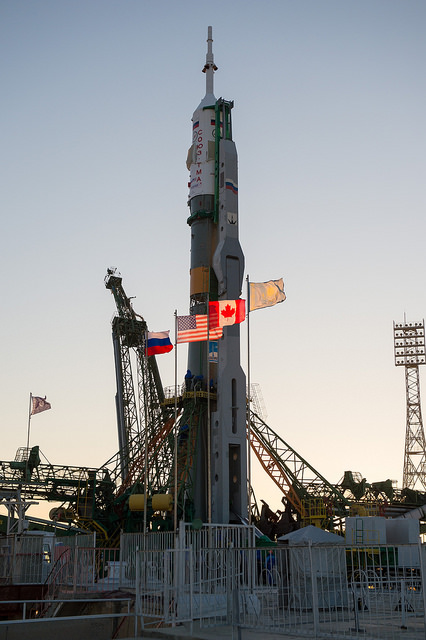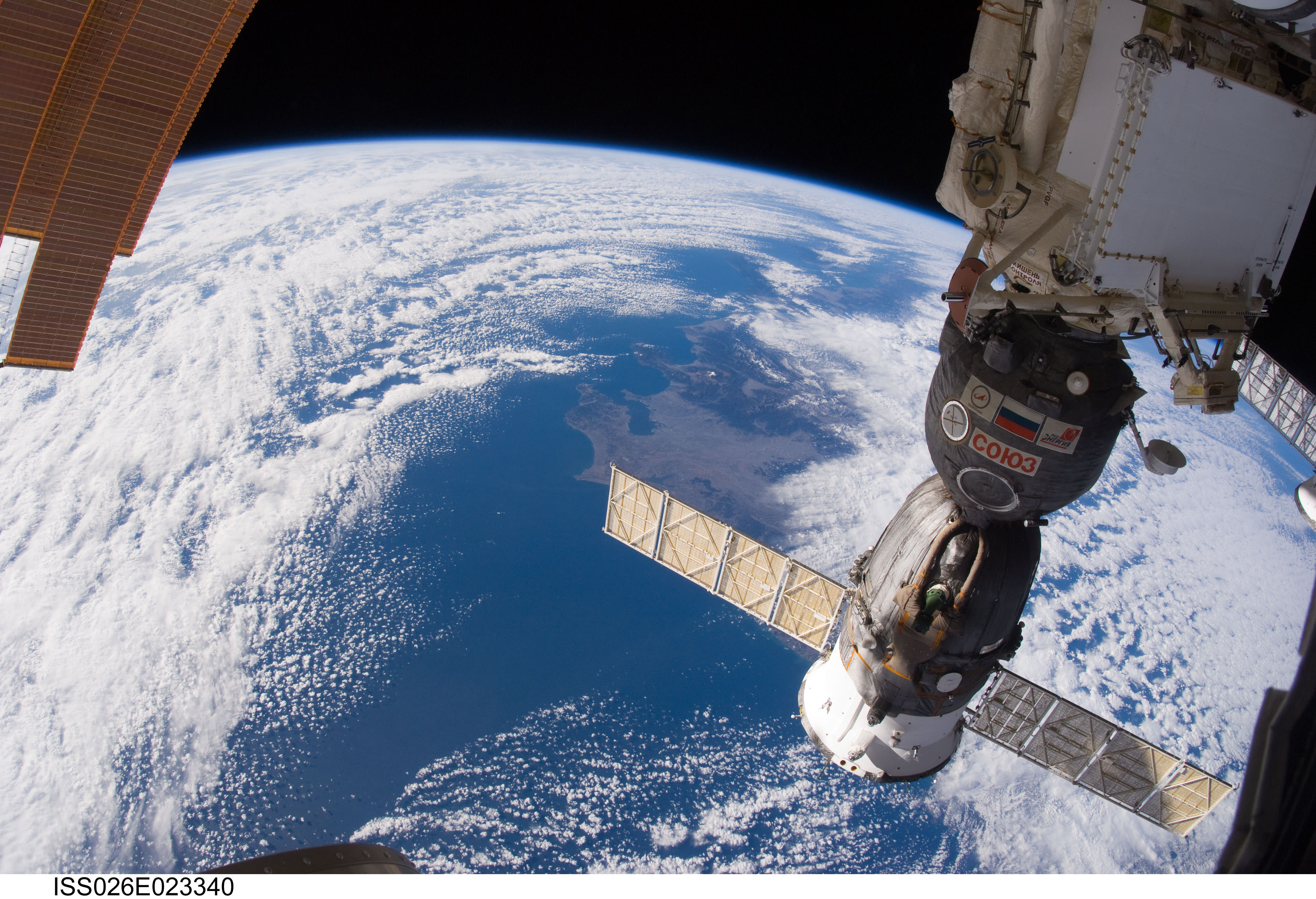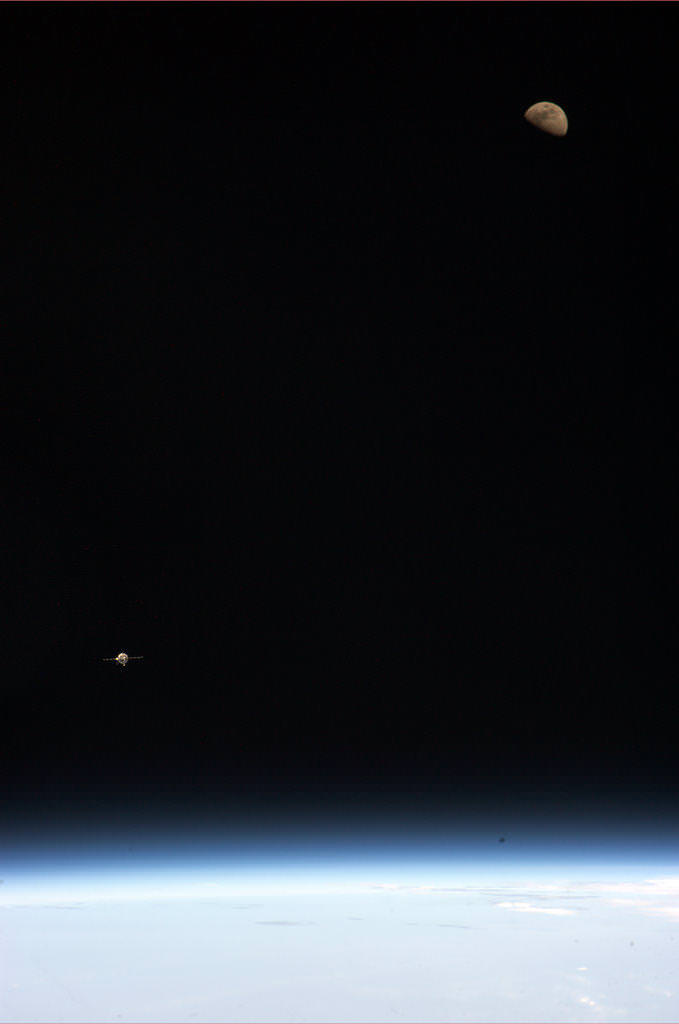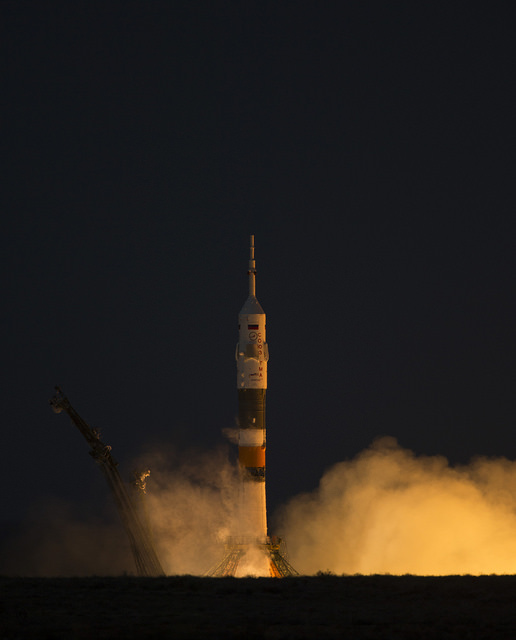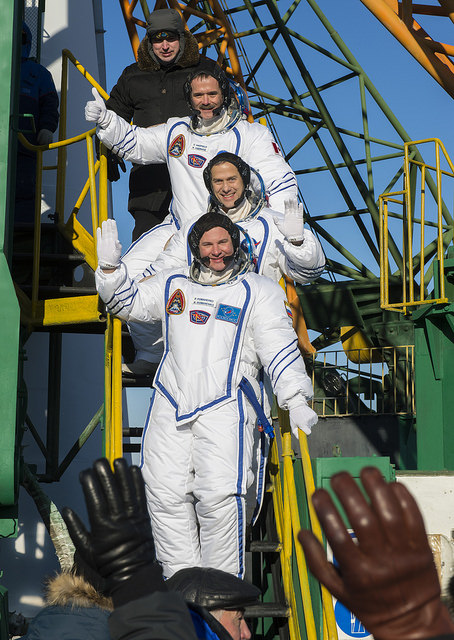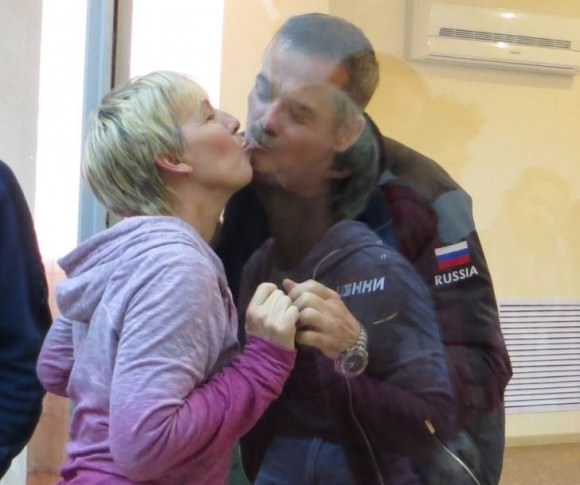Want to know more about the Soyuz rocket? This new video from ESA is based on actual lessons for astronauts about the Soyuz rocket and describes the parts of the Soyuz, the stages and launch sequence. The info here was part of ESA Basic Training for the ESA astronaut class of 2009 (also known as the Shenanigans09).
Soyuz Crew Sets Record for Fastest Trip to Space Station
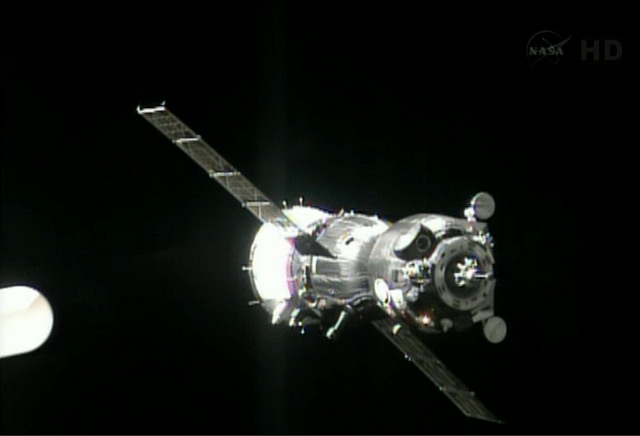
The crew of Expedition 36 aboard the Soyuz TMA-09M set a record for the fastest trip ever to the International Space Station. From launch to docking, the trip took 5 hours and 39 minutes. That’s six minutes faster than the previous Soyuz that used the new “fast track” four-orbit rendezvous.
Soyuz Commander Fyodor Yurchikhin of the Russian Federal Space Agency (Roscosmos), NASA astronaut Karen Nyberg and European Space Agency (ESA) astronaut Luca Parmitano docked their Soyuz to the station’s Rassvet module at 02:16 UTC on May 29 (10:16 p.m. EDT on May 28).
“Thank you for the best spacecraft, finer than the best pocket watch!” Yurchikhin radioed to Mission Control in Moscow after docking.
Docking and hatch opening videos below:
Launch took place at 20:31 UTC (4:31 p.m. EDT) Tuesday (2:31 a.m. May 29, Baikonur time).
The new abbreviated rendezvous with the ISS uses a modified launch and docking profile for the Russian ships. It has been tried successfully with three Progress resupply vehicles, and this is the second Soyuz crew ship that has used it.
In the past, Soyuz manned capsules and Progress supply ships were launched on trajectories that required about two days, or 34 orbits, to reach the ISS. The new fast-track trajectory has the rocket launching shortly after the ISS passes overhead. Then, additional firings of the vehicle’s thrusters early in its mission expedites the time required for a Russian vehicle to reach the Station.
After the hatches open at 11:55 p.m. EDT, the new trio will join Flight Engineer Chris Cassidy of NASA and Commander Pavel Vinogradov and Flight Engineer Alexander Misurkin of Roscosmos who have been on board since March 28. All six crew members will then participate in a welcome ceremony with family members and mission officials gathered at the Russian Mission Control Center in Korolev near Moscow.
Hadfield, Marshburn and Romenko Return Safely to Earth
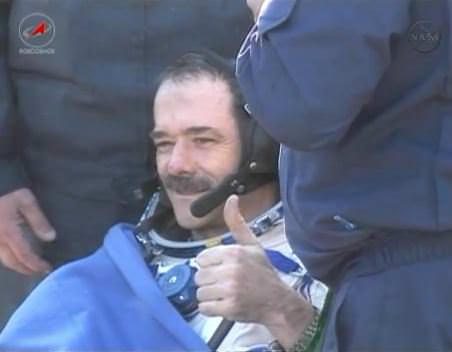
Coming home to clear blue skies, green grass and warm weather, the Expedition 35 crew of Canadian astronaut Chris Hadfield, NASA’s Tom Marshburn and Russia’s Roman Romanenko has returned after spending just over five months on the International Space Station. “It’s beautiful!” one of the crew radioed in Russian just before landing. “It’s morning here.”
The Soyuz TMA-07M spacecraft landed right on target on the steppe of Kazakhstan, southeast of Dzhezkazgan at 10:31 pm EDT on May 13 (02:31 UTC and 8:31 am local time, May 14, 2013.) The crew undocked from the ISS on Monday.
Keeping with his Expedition-long constant updates via Twitter (updated by his son Evan during the return flight and landing) Hadfield’s location changed appropriately to “In a Soyuz” to “In a field in Kazahkstan.”
A few hours later, Hadfield tweeted, “Safely home – back on Earth, happily readapting to the heavy pull of gravity. Wonderful to smell and feel Spring.”
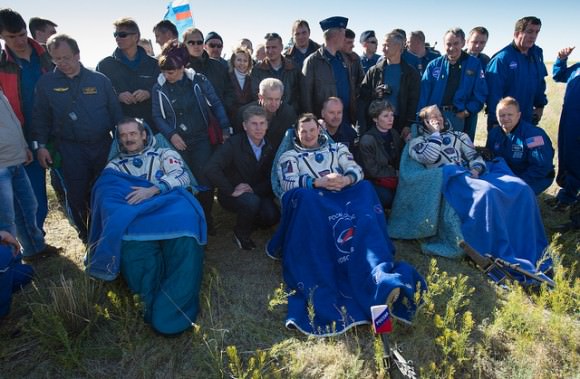
The crew smiled and gave thumbs up after being extracted from the Soyuz craft, which appeared to land upright and then tipped on its side. Hadfield and Marshburn will soon head back to Johnson Space Center in Houston, with Romanenko going to Star City, Russia.
The Expedition 35 crew has now wrapped up 146 days in space, 144 days on the ISS. While on board they completed 2,336 orbits around the planet and clocked almost 100 million kilometers (62 million miles) In total, Marshburn has spent 162 days in space, 166 days for Hadfield, and 334 days for Romanenko.
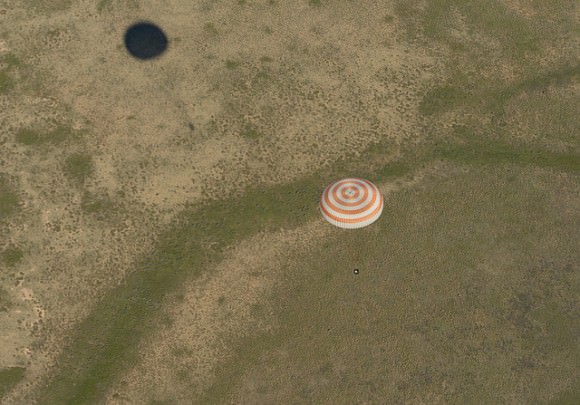
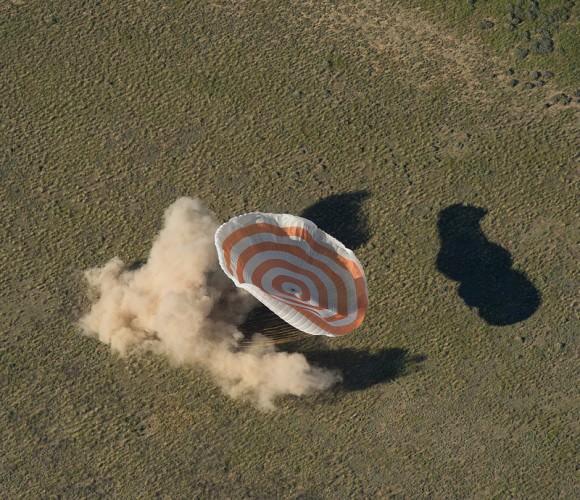
This video shows the crews saying goodbye; then later the undocking, followed by the landing and crew extraction:
Happy Easter Sunday from the ISS ! Crew Hunts Easter Eggs & Goodies
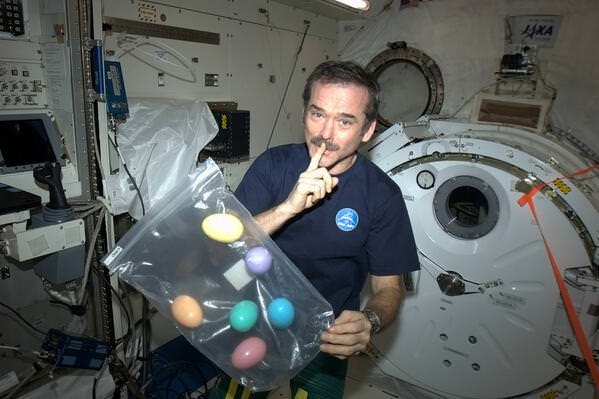
ISS Commander Chris Hadfield plans surprise Easter egg hunt for station crew today – Easter Sunday, March 31, 2013. Credit: NASA/Chris Hadfield
Updated with more astounding ‘Easter from Space’ photos by Chris Hadfield !
Dont miss the scrumptious ‘Easter Finale’ – below
Thank you Chris ![/caption]
Hush, hush !
Don’t’ tell his crew, but Canadian astronaut Chris Hadfield has secretly planned a delightful space station surprise sure to also warm the hearts of Earth’s children celebrating the joyous occasion of this Easter Sunday – and there’s delicious photos below too.
They’re going on an Easter egg hunt !
“Don’t tell my crew, but I brought them Easter Eggs :)”, tweeted Hadfield from the ISS – where he currently serves as Commander of the Expedition 35 crew.
And Hadfield sends his greetings and ‘Easter from Space’ photos to all of us down here on the good Earth on this Holy Day.
“Good Morning, Earth! A fine Easter Sunday morning to you, from the crew of the International Space Station.”
You can follow along with Hadfield’s adventures from space as – @Cmdr_Hadfield
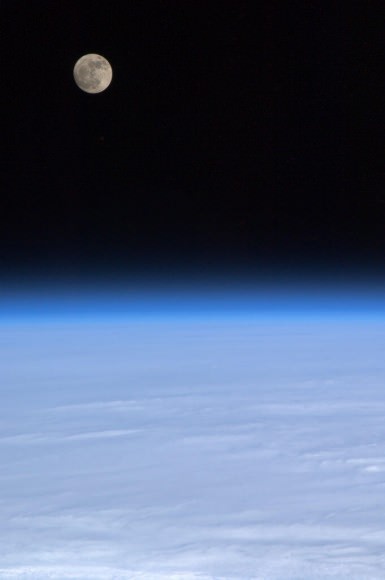
Occasionally, Mission Control relents and lets the astronauts have fun, taking a break from their out of this world chores.
But given the weightless of space, it’s not obvious how they’ll accomplish the traditional Easter egg roll. Perhaps we’ll hear about that later.
And there’s no word back yet on Easter Bunny sightings.
Well, to get ready Hadfield has been busy stashing assorted Easter goodies & gifts in the gazillion nooks and crannies aboard the ISS – and snapping fun photos for all the kids to play along.
“Sometimes the best place to hide an item is floating right above your nose. Or in this case, your sleep pod.”
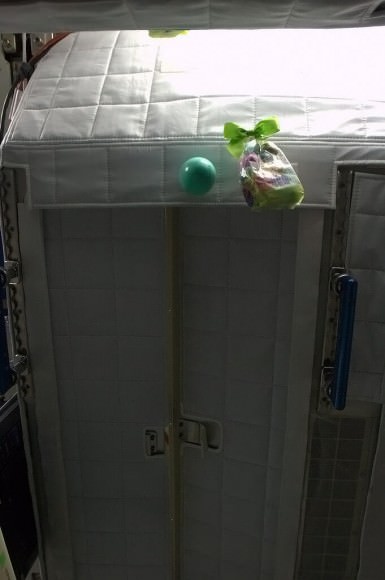
Hadfield just couldn’t resist the temptation of some weightless juggling – and he’s not telling if they went .. splat !!
“It appears that I’m as bad at juggling in weightlessness as I am on Earth. Hopefully I’m better at hiding them… ”
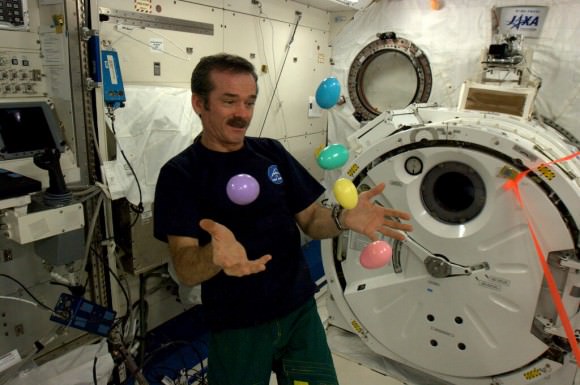
Time will tell whether the crew of six guys are indeed clever enough to figure out all the secret hiding spots.
The Easter egg hunt could be especially trying for the three ‘new guys’ who just arrived on Thursday, March 28, on the Russian Soyuz express capsule – comprising of Russian cosmonauts Pavel Vinogradov and Alexander Misurkin and NASA astronaut Chris Cassidy. They join Hadfield, astronaut Tom Marshburn and cosmonaut Roman Romanenko who will stay aboard the station until May.
In the meantime, Hadfield is playfully diverting everyone’s concentration with gorgeous shots of Earth, like the Easter sunrise glinting across North America’s heartland – below.
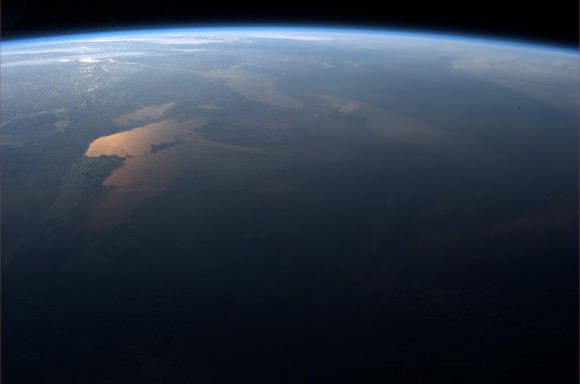
And the Canadian Space Agency has now passed along an Easter greeting card.
Astronaut and cosmonaut crews have a decade’s long tradition of celebrating religious holidays in space. Probably the most famous occasion was when the three man American crew of Apollo 8 read scriptures from Genesis marking the first time in history that humans were orbiting the Moon – back in 1968.
All in all it’s been a busy week aboard the massive orbiting lab complex.
On Tuesday, March 26, the SpaceX Dragon capsule departed the station, loaded with a long awaited trove of science goodies and successfully splashed down in the ocean. Two days later the trio of new space men arriving aboard the Soyuz restored the ISS to its full crew complement of six.
Since arriving at the station just before Christmas 2012, Hadfield has been doing a stellar job enlightening folks about what it’s like to live and work in space in fun and understandable ways.
Happy Easter !
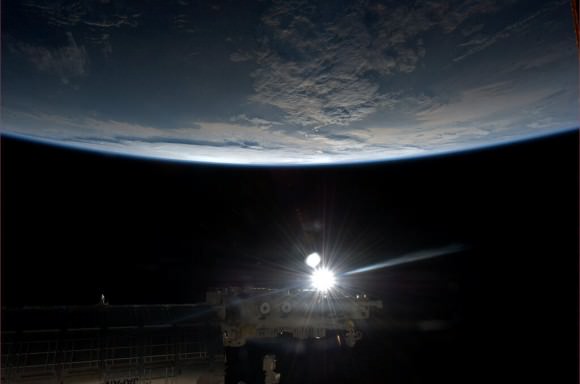
…………….
Learn more about the ISS, Curiosity, SpaceX, Antares, and NASA missions at Ken’s upcoming lecture presentations:
April 20/21 : “Curiosity and the Search for Life on Mars – (in 3-D)”. Plus Orion, SpaceX, Antares, ISS, the Space Shuttle and more! NEAF Astronomy Forum, Suffern, NY
April 28: “Curiosity and the Search for Life on Mars – (in 3-D)”. Plus the Space Shuttle, SpaceX, Antares, Orion and more. Washington Crossing State Park, Titusville, NJ, 130 PM
Space Station Crew Captures Soyuz Launch, As Seen from Orbit
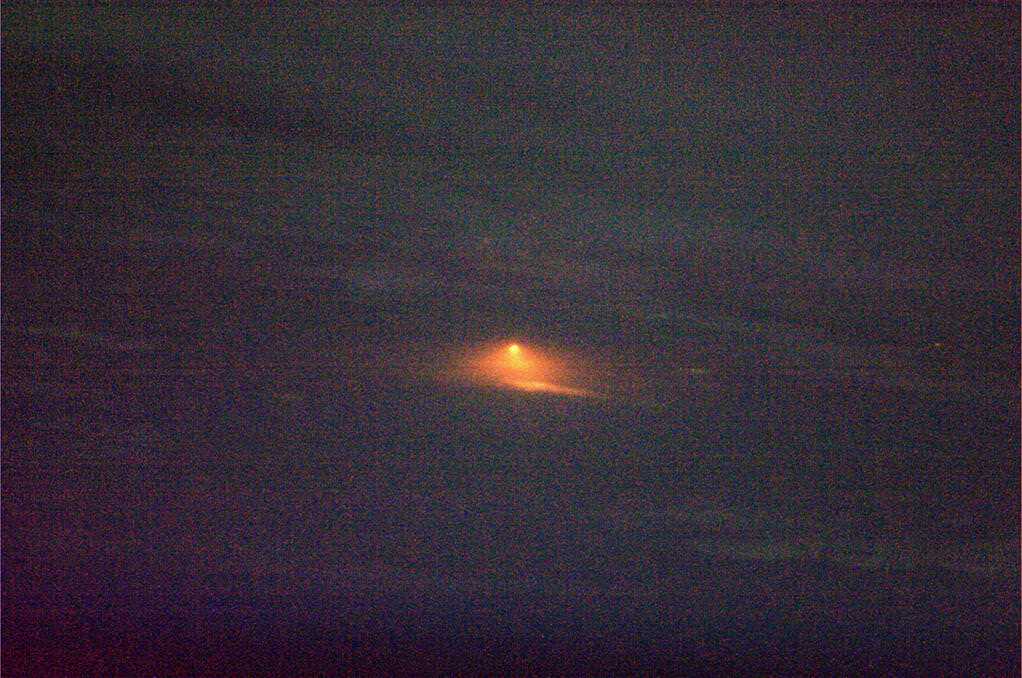
Just how much activity on Earth can be seen from orbit? In the dark of night, the Soyuz rocket launch on March 29/28, 2013 was bright enough to be seen by the International Space Station crew 350 km (220 miles) above. “Soyuz Rocket Launch – the moment of ignition, as-seen from their target, the Space Station,” tweeted ISS commander Chris Hadfield in sharing this image.
The new fast-track trajectory used for the first time for a crewed Soyuz has the rocket launching shortly after the ISS passes overhead, and so the ISS was in the perfect spot for the crew to witness the launch with their own eyes — at least with a camera and a zoom lens. The Soyuz TMA-08M spacecraft launched at 2:43 a.m. Friday local time from the Baikonur Cosmodrome in Kazakhstan (4:43 p.m. EDT, 20:43 UTC on March 28), carrying the crew of Pavel Vinogradov, Aleksandr Misurkin and Chris Cassidy.
The fast-track launch had the crew arriving in just 5 hours and 45 minutes after launch. This is the first crew to use this quick trajectory. It came with the added bonus of the launch being visible from space.
Watch “Fast-Track” Launch of Soyuz Live

Watch live the first “fast-track” human Soyuz flight to the International Space Station. The Soyuz TMA-08M crew will arrive at the ISS just five hours and 49 minutes after launch instead of the usual two days. Commander Pavel Vinogradov, flight engineer Alexander Misurkin and NASA astronaut Christopher Cassidy are scheduled for liftoff from the Baikonur Cosmodrome in Kazakhstan at 20:43 UTC (4:43:20 p.m. EDT) on Thursday, March 28, 2013. (If you missed the launch live, watch the video of it below:)
Continue reading “Watch “Fast-Track” Launch of Soyuz Live”
Expedition 34 Crew Gets a Foggy Welcome Home
Three members of the Expedition 34 crew undocked from the International Space Station a day later than originally planned on Friday due to bad weather in the landing area in Kazakhstan, but returned safely to Earth, despite continuing cold, foggy weather. The deteriorating weather conditions allowed only two of 12 search and rescue helicopters to land at the touchdown site because of heavy clouds and fog. NASA TV was unable to show the actual landing after the Soyuz capsule descended into the dense fog.
Continue reading “Expedition 34 Crew Gets a Foggy Welcome Home”
Next Soyuz Crew Will Take 6-Hour Fast-Track to Space Station
The next Soyuz crew will be the first to try out the new abbreviated four-orbit rendezvous with the International Space Station. This relatively new, modified launch and docking profile for the Russian ships has been tried successfully with three Progress resupply vehicles, and now Roscosmos and NASA have agreed to try it on a human flight.
“We tried this approach on the cargo vehicles, and now we will try to do it on the manned vehicles,” said Sergei Krikalev, former cosmonaut, who now leads the Gagarin Cosmonaut Training Center near Moscow, speaking through an interpreter on NASA TV. “Now we have onboard new machinery and new software, so the vehicle is more autonomous, so it’s possible to do a lot onboard the vehicle and to calculate the burns so they don’t consume a lot of fuel.”
In the past, Soyuz manned capsules and Progress supply ships were launched on trajectories that required about two days, or 34 orbits, to reach the ISS. The new fast-track trajectory has the rocket launching shortly after the ISS passes overhead. Then, additional firings of the vehicle’s thrusters early in its mission expedites the time required for a Russian vehicle to reach the Station.
Liftoff of the Soyuz TMA-08M spacecraft is scheduled for 4:43 p.m. EDT (20:43 UTC) on March 28 from the Baikonur Cosmodrome in Kazakhstan. Docking is set for 10:31 p.m. EDT (02:31 UTC).
“The Soyuz is not the most comfortable vehicle to be in for an extended period of time,” said NASA astronaut Chris Cassidy who is part of the Expedition 35/36 crew who will make the first fast-track flight. “The toilet is right next to where you sleep which are right next to your buddy and eating and all; it’s like living for a day in a smart car or a Volkswagen Beetle….So the benefit to us is we get to the space station faster with the facilities that it offers, much more comfortable type of environment to be in and it also demonstrates some technology that’s useful in getting to the space station on that same day.”
One of the reasons given in the past for having the two-day or even three-day flight in the Soyuz was to allow the crew members time to get acclimated to being in a weightless environment. This new fast approach doesn’t allow for that, but Cassidy said he doesn’t think that thinking is really applicable, since the cramped Soyuz is so different from the voluminous space station.
“The adaptation of that I think is a little bit different,” he said. “You’re really not truly adapting in that day and a half. Two days on the Soyuz, that same adaptation that you’ll have once you get to the space station just because it’s a different perspective for your brain to get its arms around.”
The Soyuz took the first crew to the International Space Station in November 2000, and since that time, at least one Soyuz has always been at the Station, generally to bring the crews back and forth, but also to serve as a lifeboat should the crew have to return to Earth unexpectedly. Now that the space shuttles have been retired, the Soyuz is currently the only way for ISS crews to go to and from the Station. When there is a full crew of six on board, that means two Soyuz are docked at the ISS.
SpaceX is shooting for sometime in 2015 for the first crew flights of the Dragon to the ISS.
Lovely Image from Space: Earth, Moon and Approaching Spacecraft
Earth, Moon and Soyuz. Credit: NASA/Kevin Ford.
This one might have to be added to the group of iconic images from space. On December 21, a Soyuz spacecraft carrying new crewmembers approached the International Space Station. Commander Kevin Ford, already on the ISS, took this image showing the Moon above, bright blue Earth below and the Soyuz coming into view. “Science fiction into fact,” said Canadian Chris Hadfield, who was on board the Soyuz, along with Roman Romanenko and Tom Marshburn.
By the way, if you aren’t following Chris Hadfield on Twitter or Facebook, you really should. He’s posting several images and lots of updates daily of what his life is like on board the space station. You can read about his training in our series of articles about it, and we plan to keep following Hadfield’s mission and will be writing more about his expedition in 2013.
International Crew Launches to Space Station
The Soyuz TMA-07M rocket launches from the Baikonur Cosmodrome in Kazakhstan on Wednesday, Dec. 19, 2012 carrying the Expedition 34 crew to the International Space Station. Credit: NASA/Carla Cioffi
Heading off just as the Sun was setting amid frigid conditions at the Baikonur Cosmodrome in Kazakhstan, a trio of international explorers launched to space, on their way to the International Space Station. Chris Hadfield of the Canadian Space Agency, Tom Marshburn of NASA, Roman Romanenko of the Russian Federal Space Agency (Roscosmos) launched Wednesday at 12:12 UTC (7:12 a.m. EST, 6:12 p.m. Baikonur time). Their Soyuz TMA-07M performed flawlessly, and the crew is expected to dock with the Rassvet module on the Russian segment of the space station at 14:12 UTC (9:12 a.m. EST) on Friday, Dec. 21.
See the launch video below:
Temperatures were below freezing, with a windchill reported of -34 C at launch time. But as Hadfield told Universe Today, the Soyuz rocket is just as robust and one of the most reliable rockets ever. “The Soyuz launches all-weather, -40 degrees to +40 degrees,” Hadfield said. “It is rugged, built on experience, and it is not delicate. I trust it with my life.”
Hadfield, Marshburn and Romanenko will join their Expedition 34 crewmates already on board the ISS — Commander Kevin Ford and Flight Engineers Oleg Novitskiy and Evgeny Tarelkin — to bring the crew back to the standard size of six.
Two minutes into flight, the Soyuz rocket’s four liquid-fueled first stage boosters were jettisoned. Via NASA TV.
Hadfield will make history on March 15, 2013 as he will become the first Canadian astronaut to take command of the ISS.
The focus of Expedition 34/35 is scientific research, with the astronauts serving as subjects for human physiology tests, including examinations of astronaut bone loss.
While not officially decided yet, Hadfield indicated a spacewalk may be in order for him and one of his ISS crewmates to perform some needed maintenance outside the space station.
Expedition 34 NASA Flight Engineer Chris Hadfield of the Canadian Space Agency (CSA), top, NASA Flight Engineer Tom Marshburn and Soyuz Commander Roman Romanenko wave farewell from the bottom of the Soyuz rocket. Credit: (NASA/Carla Cioffi)
During their stay, the crew will be busy welcoming both a Russian Progress and ESA’s ATV cargo ships, as well as two commercial resupply missions from SpaceX and the first flight of Orbital Science’s Cygnus spacecraft.
The crew also will also be conducting a wide range of physical science, Earth observation, human research and technology demonstration investigations. Experiments will investigate how fire behaves in space, which could help improve engine fuel efficiency and fire suppression methods in space and on Earth. Other research will look at fluids that change physical properties in the presence of a magnet, which could improve bridge and building designs to better withstand earthquakes. With the help of cameras set up by the crew, students on Earth are capturing photos of our planet.
For a look at the training done by Chris Hadfield in preparation for his flight, see our series “How to Train for Long Duration Space Flight.”
“One last kiss before I go – love under glass with my wife. It’s launch morning, I slept well, feel great,” Hadfield Tweeted this morning before launch.

